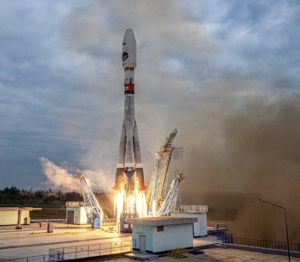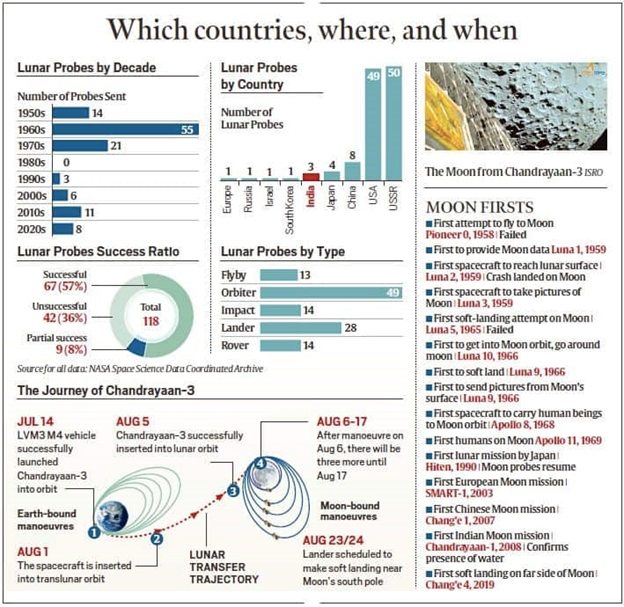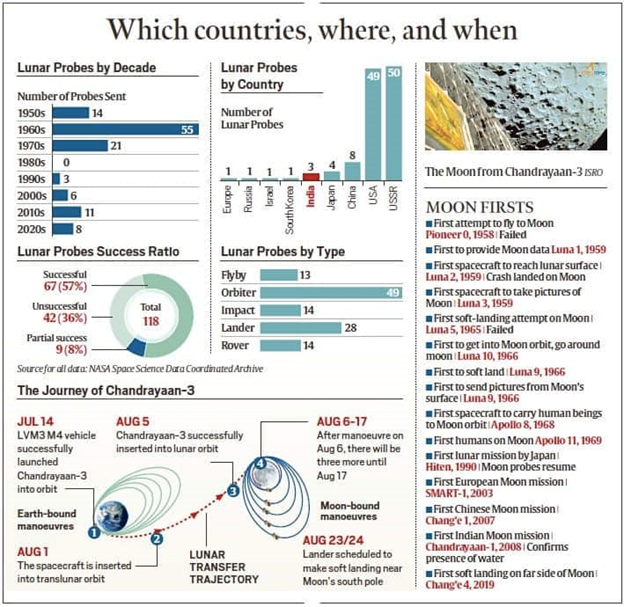Understanding the failure of Luna 25.
Relevance
- GS Paper 3 Science & Technology.
- Tags: #upsc #Roscosmos #Luna25 #Moon #Russia #Chandrayaan3.
Why in the news?
- On August 11, Roscosmos, the Russian space agency, launched its Luna 25 spacecraft onboard a Soyuz 2 rocket. But on August 20, Roscosmos stated that Luna 25 had suffered a glitch and crashed on the moon’s surface the previous day, ending the mission in a failure.
- In its statement, Roscosmos said that it would put together a committee to investigate the precise mode of failure of Luna 25. Beyond that, it has only said that the spacecraft suffered a technical problem.
- Whatever the technical reasons for Luna 25’s failure, it’s clear that Russia is falling behind vis-à-vis going to the moon.
Current Situation
- On August 11, Roscosmos, the Russian space agency, launched its Luna 25 spacecraft onboard a Soyuz 2 rocket. Luna 25 consisted of a lander and its mission was to soft-land near the moon’s south pole and study the properties of lunar soil and the atmosphere.
- But on August 20, Roscosmos stated that Luna 25 had suffered a glitch and crashed on the moon’s surface the previous day, ending the mission in a failure.
Luna-25 Mission
- Luna 25 was a Russian lunar lander mission by Roscosmos in August 2023 that was slated to land near the lunar South Pole at the crater Boguslawsky.
- A Soyuz 2.1v rocket carrying the Luna-25 craft blasted off from the Vostochny cosmodrome, 5,550 kilometers east of Moscow, on August 11. On August 21, the lander is anticipated to make contact with the moon, according to Russia’s space chief.
- India’s lunar mission cannot touch down until August 23, when the landing spot would see lunar sunrise. On the moon’s South Pole, Luna-25, a vehicle about the size of a small car, plans to run continuously for a year.
Why did Russia launch Luna 25?
- The Luna 25 mission has been in the works for more than two decades. It was initially called Luna-Glob and the name was later changed to make the mission a part of the Luna series, the last edition of which was launched in 1976.
- In its statement, Roscosmos said one of the mission’s purposes was to “ensure Russia’s guaranteed access to the moon’s surface” — an allusion to the growing importance of the moon as a spaceflight destination. While Russia and China are together leading the International Lunar Research Station (ILRS), versus the U.S.-led Artemis Accords, Russia has not executed a successful interplanetary mission in 34 years now.
- Some experts have also said that Russia intended Luna 25 as President Vladimir Putin’s demonstration that the country’s economy — including the spaceflight sector — hasn’t buckled under the weight of international sanctions following Mr. Putin’s invasion of Ukraine in 2022.
Were the two missions in a race?
- Too many details are misaligned to expect that Luna 25 and Chandrayaan 3 were in a race. Both missions were launched in a similar timeframe and were expected to attempt a soft-landing on the moon within days of each other.
- However, these mission parameters are determined by the launch vehicle, the mass of the spacecraft, the earth-moon trajectory, and availability of sunlight at a point on the moon.
- In addition, while Chandrayaan 3 has been in development since 2019, Roscosmos was working on Luna 25 since the early 2010s. Both missions also suffered delays due to the COVID-19 pandemic.
- Finally, recall that Russia pulled out of building the lander for Chandrayaan 2 due to delays imposed by the failure of the former’s Fobos-Grunt mission in 2011.
- Roscosmos and the Indian Space Research Organisation (ISRO) have otherwise been partners; the former is also helping train Indian astronauts for the Gaganyaan mission.
- Therefore, Luna 25 and Chandrayaan 3 couldn’t have been in a race.
Russia’s Lunar Exploration History
- The last successful Russian lunar landing took place in 1976, leaving a sizable gap in the nation’s lunar exploration efforts.
- This historical context is made clearer by the Luna-25’s failure, which highlights the enormous difficulties that lunar missions involve.
- Despite this protracted break, Russia has shown tenacity and perseverance in its quest for lunar exploration.
Luna 25 vs Chandrayaan 3
Luna-25 has a leaner lift-off mass of only 1,750 kilograms, significantly lighter than Chandrayaan-3’s 3,800 kg. This reduced mass allows Luna-25 to accelerate more effectively, according to India’s space agency ISRO.
| Difference | Luna 25
|
Chandrayaan 3
|
| Definition | After 47 years, Russia returns to lunar exploration with Luna 25, hoping to restore its standing in space exploration. | India’s third lunar mission, Chandrayaan-3, marks the country’s second attempt at a gentle lunar landing. |
| Payload Difference | In order to examine soil composition, dust particles, and surface water detection, Luna 25 is lighter and does not have a rover. | Chandrayaan-3 is equipped with a rover that can go 500 metres, contains equipment to find water ice in shadowed craters close to the lunar South Pole, and is designed to explore the lunar soil. |
| Lifespan | Luna 25 has heating mechanisms and a non-solar power source because it is built for an extended mission of a year. | As a result of inadequate heating during the lunar nights, Chandrayaan-3 is designed for a single lunar day. |
| Objective | The eight payloads on the Russian lander are primarily used to detect surface water, analyze soil composition, and analyze dust particles in the polar exosphere. | Scientific equipment is also available on the Indian mission to analyse the lunar soil and water ice. Because there are craters close to the southern polar region that are always in darkness, there is a higher chance of finding water ice there. |
What happened to Luna 25?
- In its statement, Roscosmos said that it would put together a committee to investigate the precise mode of failure of Luna 25.
- Beyond that, it has only said that the spacecraft suffered a technical problem that took its operation beyond the parameters within which the mission was designed to operate.
- Speculation on social media platforms by spaceflight experts has centered on one event: that as Luna 25 attempted to modify its circular orbit around the moon to a lower pre-landing orbit, it applied more thrust than required, sending it careening to the surface.
- Roscosmos itself lost contact with Luna 25 as it was performing this manoeuvre, suggesting that the manoeuvre took it out of lunar orbit. Roscosmos Director-General Yury Borisov has said that an engine that was supposed to fire for 84 seconds did so for 127 seconds instead.
Why couldn’t Roscosmos rescue it?
- At the moment, NASA and the European Space Agency are helping ISRO track Chandrayaan 3 around the moon. Their antennae will maintain contact with the ‘Vikram’ lander as it attempts its soft-landing on August 23.
- But after Russia invaded Ukraine, it lost the goodwill of many countries worldwide, provoking economic sanctions.
- One less-known consequence was that Russia lost its privilege to use satellite tracking systems operated by countries in different parts of the world. As a result, Roscosmos could contact Luna 25, and receive signals from the spacecraft, only at three stations: two in Russia and one in Russia-annexed Crimea.
- In other words, Roscosmos could communicate with Luna 25 only when the moon was directly over Russia.
- So the size of the window that scientists had to fix the problem and salvage the mission was much smaller. They did attempt to contact the lander in this window but it didn’t respond.
What next for Russia?
- Whatever the technical reasons for Luna 25’s failure, it’s clear that Russia is falling behind vis-à-vis going to the moon. Before the ILRS, Russia had joined hands with NASA to build a near-moon space station.
- But even before it backed out of the partnership in 2021, its role in the enterprise was found to be highly limited.
- Under ILRS, Roscosmos has already planned for Luna missions 26 and 27 as part of the first phase of operations, which include technology demonstration and site selection for future lander missions.
- Now, with the failure of Luna 25 and the sanctions imposed by Western countries — which will limit the components that Russia can import — their respective launch dates could be pushed further from 2027 and 2028. So in the ILRS as well, Russia’s role may become limited.
Different Mission
Luna Program (Soviet Union/Russia)
- Luna 2 (1959): First human-made object to reach the moon.
- Luna 9 (1966): First successful soft landing on the moon, sent back images.
- Luna 16 (1970): Successfully returned lunar soil samples to Earth.
- Luna 24 (1972): Collected and returned lunar soil samples.
Apollo Program (USA)
- Apollo 11 (1969): First manned mission to land on the moon. Neil Armstrong and Buzz Aldrin walked on the lunar surface.
- Apollo 12, 14, 15, 16, 17: Follow-up missions with successful lunar landings, scientific experiments, and moonwalks.
Chang’e Program (China)
- Chang’e 3 (2013): Successfully landed a rover, Yutu, on the moon’s surface.
- Chang’e 4 (2019): Landed on the far side of the moon and deployed the Yutu-2 rover.
- Chang’e 5 (2020): Collected lunar samples and returned them to Earth.
Lunar Reconnaissance Orbiter (USA)
Launched in 2009 to study the moon’s surface and gather data for future lunar missions.
Chandrayaan Program (India)
- Chandrayaan-1 (2008): Detected water molecules on the lunar surface and mapped the moon’s composition.
- Chandrayaan-2 (2019): Orbiter, lander, and rover mission. Orbiter is operational and studying the moon.
- Chandrayaan-3 (2023): Pragya (Rover) and Vikram (Lander) has landed the lunar surface.
Lunar Impact Missions
- SMART-1 (European Space Agency) and Moon Impact Probe (India) were missions that deliberately impacted the moon to study its surface.
- Artemis Program (USA): Planned program aiming to return humans to the moon. Upcoming un-crewed mission.
- Yutu-2 Rover (China): Part of the Chang’e 4 mission, this rover continues to explore the far side of the moon.
- The Revival of Lunar Exploration: A New Era of Moon Missions.
The moon is set to witness a flurry of activity in the upcoming days as multiple spacecraft from different countries prepare to land on its surface. Chandrayaan-3 from India, Russia’s Luna 25, and Japan’s SLIM (Smart Lander for Investigating Moon) are all scheduled to touch down around the same time, potentially marking the first instance of three spacecraft operating simultaneously on the lunar surface.
Conclusion
- Luna-25’s success will likely pave the way for further lunar missions and exploration activities, boosting Russia’s profile in the global space community.
- Russia’s renewed lunar ambitions highlight the enduring importance of lunar exploration in advancing scientific knowledge, resource utilization, and space exploration.
- In conclusion, Russia’s Luna-25 lunar lander mission holds great promise for advancing our understanding of the moon’s south pole region and its potential for supporting future human activities.
- As nations collaborate and compete in exploring the cosmos, Luna-25 symbolizes Russia’s commitment to embracing the challenges of space exploration and contributing to humanity’s quest for knowledge beyond Earth.
- The present era of lunar exploration reflects a shift from the competitive space race of the past to a collaborative effort with far-reaching objectives.
- The advancements in technology, understanding of the moon, and the quest for deeper space exploration have reshaped the motives behind lunar missions. The moon, once a symbol of Cold War rivalry, now represents a potential platform for humanity’s broader exploration of the cosmos.
Source: The HIndu






